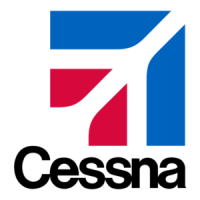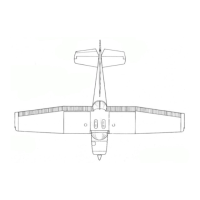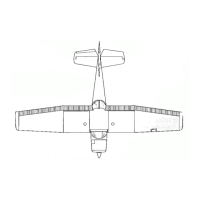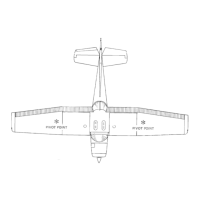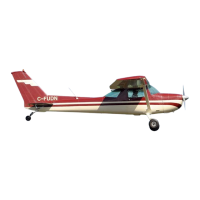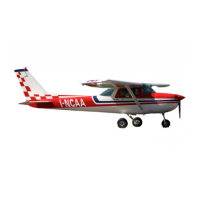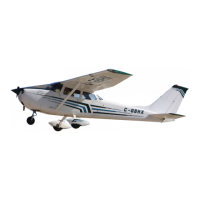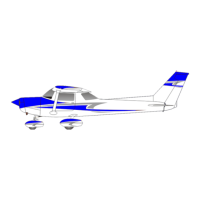Do you have a question about the Cessna 150 1969 and is the answer not in the manual?
Exterior inspection procedures before entering the aircraft.
Pre-engine start checks and procedures.
Procedures for starting the aircraft engine.
Comprehensive checks and procedures before takeoff.
Steps for normal and maximum performance takeoffs.
Steps for normal and maximum performance climbs.
Procedures for normal aircraft cruising operations.
Procedures to prepare for landing.
Steps for a standard landing.
Procedures to follow after landing the aircraft.
Steps to safely secure the aircraft after operation.
Details on how the aircraft fuel system operates and its components.
Explanation of the aircraft's electrical power generation and distribution.
How to read and interpret the ammeter readings.
Protection devices for the electrical system and their function.
Description and operation of the optional map light.
Guidelines for using the optional flashing beacon.
How the cabin climate control system works.
Operation and function of the parking brake.
Detailed procedures for starting the aircraft engine.
Procedures and safety guidelines for ground taxiing.
Comprehensive checks and procedures before takeoff.
Steps for normal and maximum performance takeoffs.
Recommended flap settings for various flight phases.
Techniques for taking off in crosswind conditions.
Steps for normal and maximum performance climbs.
Optimal airspeeds for different climb profiles.
Procedures for executing a go-around.
Procedures for normal aircraft cruising.
Characteristics and warning indicators for stalls.
Steps for normal and short field landings.
Techniques for landing in crosswind conditions.
Procedures for operating the aircraft in cold weather.
Details on approved flight operations for the aircraft.
Permitted maneuvers within the utility category.
Certificated calibrated airspeed limitations for the airplane.
Color-coded markings on the airspeed indicator.
Limitations for engine power and speed.
Operating ranges and markings for engine instruments.
Guidelines for calculating aircraft weight and balance.
Methods for safely maneuvering the aircraft on the ground.
Steps for securely tying down the parked airplane.
Cleaning and maintenance instructions for plastic windshields.
Guidelines for cleaning and maintaining painted exterior surfaces.
Care instructions for clad aluminum aircraft surfaces.
Preflight inspection and maintenance for propeller blades.
Procedures for cleaning the aircraft interior upholstery and trim.
Information on required periodic inspections and service.
List of required documents to be displayed or carried in the aircraft.
Specific servicing intervals and procedures for aircraft maintenance.
List of available publications and flight operation aids.
Table for converting indicated airspeed to calibrated airspeed.
Stalling speeds under various conditions and bank angles.
Data on take-off distances under different conditions.
Data on the aircraft's maximum rate of climb.
Data on landing distances under various conditions.
Performance data for cruising at different altitudes and power settings.
Chart showing maximum glide distance based on height.
Description of optional long range fuel tanks for increased endurance.
Information on the winterization kit for cold weather operation.
Description of the optional ground service plug receptacle.
Details on the kit for daily draining and inspection of fuel tanks.
Operation of the switch for selecting radio transmitters.
Description of the optional true airspeed indicator.
Description and operation of the optional wing leveler system.
Exterior inspection procedures before entering the aircraft.
Pre-engine start checks and procedures.
Procedures for starting the aircraft engine.
Comprehensive checks and procedures before takeoff.
Steps for normal and maximum performance takeoffs.
Steps for normal and maximum performance climbs.
Procedures for normal aircraft cruising operations.
Procedures to prepare for landing.
Steps for a standard landing.
Procedures to follow after landing the aircraft.
Steps to safely secure the aircraft after operation.
Details on how the aircraft fuel system operates and its components.
Explanation of the aircraft's electrical power generation and distribution.
How to read and interpret the ammeter readings.
Protection devices for the electrical system and their function.
Description and operation of the optional map light.
Guidelines for using the optional flashing beacon.
How the cabin climate control system works.
Operation and function of the parking brake.
Detailed procedures for starting the aircraft engine.
Procedures and safety guidelines for ground taxiing.
Comprehensive checks and procedures before takeoff.
Steps for normal and maximum performance takeoffs.
Recommended flap settings for various flight phases.
Techniques for taking off in crosswind conditions.
Steps for normal and maximum performance climbs.
Optimal airspeeds for different climb profiles.
Procedures for executing a go-around.
Procedures for normal aircraft cruising.
Characteristics and warning indicators for stalls.
Steps for normal and short field landings.
Techniques for landing in crosswind conditions.
Procedures for operating the aircraft in cold weather.
Details on approved flight operations for the aircraft.
Permitted maneuvers within the utility category.
Certificated calibrated airspeed limitations for the airplane.
Color-coded markings on the airspeed indicator.
Limitations for engine power and speed.
Operating ranges and markings for engine instruments.
Guidelines for calculating aircraft weight and balance.
Methods for safely maneuvering the aircraft on the ground.
Steps for securely tying down the parked airplane.
Cleaning and maintenance instructions for plastic windshields.
Guidelines for cleaning and maintaining painted exterior surfaces.
Care instructions for clad aluminum aircraft surfaces.
Preflight inspection and maintenance for propeller blades.
Procedures for cleaning the aircraft interior upholstery and trim.
Information on required periodic inspections and service.
List of required documents to be displayed or carried in the aircraft.
Specific servicing intervals and procedures for aircraft maintenance.
List of available publications and flight operation aids.
Table for converting indicated airspeed to calibrated airspeed.
Stalling speeds under various conditions and bank angles.
Data on take-off distances under different conditions.
Data on the aircraft's maximum rate of climb.
Data on landing distances under various conditions.
Performance data for cruising at different altitudes and power settings.
Chart showing maximum glide distance based on height.
Description of optional long range fuel tanks for increased endurance.
Information on the winterization kit for cold weather operation.
Description of the optional ground service plug receptacle.
Details on the kit for daily draining and inspection of fuel tanks.
Operation of the switch for selecting radio transmitters.
Description of the optional true airspeed indicator.
Description and operation of the optional wing leveler system.
| Manufacturer | Cessna |
|---|---|
| Model | 150 |
| Year | 1969 |
| Type | Light Aircraft |
| Engine | Continental O-200-A |
| Horsepower | 100 hp |
| Wingspan | 33 ft 4 in (10.16 m) |
| Height | 8 ft 6 in (2.59 m) |
| Max Takeoff Weight | 1, 600 lb (726 kg) |
| Rate of Climb | 670 ft/min (3.4 m/s) |
| Seating Capacity | 2 |
| Cruise Speed | 107 knots |
| Service Ceiling | 14, 000 ft |
| Fuel Capacity | 26 gallons |
